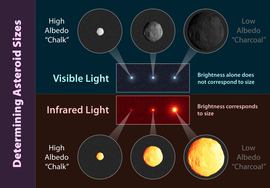Asteroids
Infrared observations are vital for detecting asteroids that might be a threat to the Earth. By measuring their orbits and size using infrared telescopes, and their composition using visible light, we can calculate both the likelihood of a collision and their mass, allowing us to assess the threat and come up with ways to move the asteroids before they can hit us.
The first asteroid, Ceres, was discovered in 1801 by Giuseppe Piazzi. We now know of over half a million asteroids.
Rocky Bodies
Asteroids are small rocky bodies in the Solar System, left over from the formation of the planets, about 4.5 billion years ago. They can range in size from a few meters across, to several hundred kilometers. Ceres is the biggest known asteroid in the Solar System, at 950 km in diameter.
Ceres is now classified as a dwarf planet, like Pluto, because it is massive enough that it is pulled into a spherical shape by its own gravity. The smaller asteroids can have all kinds of different shapes, just like big rocky boulders here on Earth.
Detecting Asteroids
Most asteroids orbit the Sun in a doughnut shaped "main belt" between the orbits of Mars and Jupiter, although many also wander about the Solar System between the planets. Some of them orbit close to Earth and are called Near-Earth Objects (NEOs). Part of NASA's mission is to find these NEOs and track them, to make sure they are not a danger to Earth.
Asteroids can be detected in both visible and infrared images, because they move across the sky with respect to stars. In this WISE image, we can see an asteroid as a red trail in the bottom right of the picture, moving past a background galaxy. Astronomers can use this movement to calculate an asteroid’s orbit. This allows us to determine whether or not it might hit the Earth, and how long we have until that happens. This is the most important piece of information when checking whether an asteroid is a danger to our planet.
Ceres originally was considered a planet until more smaller objects were found in similar orbits. Ceres is now considered to be a dwarf planet.
Measuring Asteroids
The second-most important piece of information is an asteroid's size. The bigger the asteroid, the more damage it can cause. Something that is only a few meters across might cause local damage, depending on whether it hits the ground, hits the ocean, or explodes mid-air (called an "airburst"), while an asteroid a few hundred meters across could cause massive-scale extinction, like the impact that wiped out the dinosaurs.
The meteor that exploded over Russia in February 2013 was an asteroid that was roughly 17 meters across, and made of rock, with a little bit of iron. Luckily, it caused only moderate damage, and even though it injured more than 1000 people, no one was killed.
So how do we measure the size of an asteroid? Well, this is difficult in visible light because the surface of asteroids can either be very reflective (high albedo) or very dark (low albedo). If an asteroid looks faint in visible light, it could either have a high albedo and be very small, or have a low albedo and be very big. Infrared light, though, is unaffected by the surface of the asteroid - the bigger the rock, the brighter it looks in the IR. This means that infrared observations are far more reliable in measuring an asteroid's size.
Weighing Asteroids
The next step is to determine the asteroid's mass, and to do this, we need to know what it's made of. We can measure this using both visible and infrared light. By splitting the light from an asteroid into its different colors using a spectrograph, we can look for the telltale spectral fingerprints of different minerals in the light.
Asteroids can be made from rock, ice, iron, or a mixture of all three. An asteroid of a certain size that is made of iron will have more mass than one that is made of rock or ice. This is important when calculating ways that we can move an asteroid away from the Earth: the greater the mass, the more time and more energy it takes to move it.
Scientists believe that gently nudging an approaching asteroid over a long period of time is a better idea than blowing it up.
There's also another way of measuring an asteroid's mass by using infrared light. It involves measurements of a force called the "Yarkovsky effect," along with Newton's Second Law of motion (F = ma). You can watch Cameron Diaz explain all about it in our Robot Astronomy Talk Show video.
Composition of Asteroids
There are many other scientific reasons to measure the composition of asteroids. Asteroids are rubble left over from the very beginning of the Solar System. By studying them, we can find out more about what the Earth looked like, back when it was created. This helps us to more accurately study the formation of our Solar System, and other planets around distant stars.
All observations, both in the visible and the infrared, help to determine an asteroid’s orbit, whether or not it is on a course to hit the Earth, and how much of a danger it is to us. If an asteroid headed our way is bright, icy, and small, it’s not perceived as a problem. But if it’s dark, rocky, and big, it will be seen as a potential hazard, and astronomers will continue to track it and use technology that is being developed to change the asteroid’s course.
Published: 02 August, 2013




